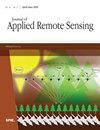评估用于人工神经网络测深建模和敏感性分析的梯度下降变化
IF 1.4
4区 地球科学
Q4 ENVIRONMENTAL SCIENCES
引用次数: 0
摘要
人工智能已广泛应用于各种环境下的水深检索,被认为对生境建模、水力结构设计和流域管理至关重要。然而,这些模型大多是针对深水开发的,梯度下降算法的关键影响往往没有得到评估。针对目前研究中的这一不足,本研究采用了人工神经网络的七种梯度下降方法,包括阶跃法、动量法、快速传播法、Δ-bar-Δ法、共轭梯度法、Levenberg-Marquardt 法和弹性反向传播法(RProp),用于浅水深度建模。然后利用无人机拍摄的多光谱图像和植被指数对台湾山区河流的浅水深度进行建模。结果表明,权值更新优化方法的性能优于基于梯度信息的方法,如 RProp。 梯度下降算法的选择至关重要,选择不当甚至可能导致性能逊于传统的线性回归模型。在灵敏度分析中,近红外和归一化差异水指数被归类为高灵敏度。通过利用多光谱数据和植被指数与 ANN,成功确定了浅水建模的最佳梯度下降算法和关键模型输入,为今后的研究提供了宝贵的启示。本文章由计算机程序翻译,如有差异,请以英文原文为准。
Evaluating gradient descent variations for artificial neural network bathymetry modeling and sensitivity analysis
Artificial intelligence has been widely applied to water depth retrieval across various environments, deemed essential for habitat modeling, hydraulic structure design, and watershed management. However, most of these models have been developed for deep waters, with the critical impact of the gradient descent algorithm often not evaluated. To address this gap in current research, this study adopted the artificial neural network with seven gradient descent methods, including step, momentum, quick propagation, delta-bar-delta, conjugate gradient, Levenberg–Marquardt, and resilient backpropagation (RProp), for shallow water depth modeling. Shallow water depths in Taiwan’s mountainous rivers were then modeled using multispectral imagery taken by drone and vegetation indices. From our results, it was revealed that methods optimizing weight updates were outperformed by those based on gradient information, such as RProp. The selection of gradient descent algorithm was identified as pivotal; an inappropriate selection might even result in performance inferior to a traditional linear regression model. In the sensitivity analysis, near-infrared and normalized difference water index were classified as highly sensitive. By leveraging multispectral data and vegetation indices with ANN, the optimal gradient descent algorithm and the critical model input for shallow water modeling were successfully identified, offering invaluable insights for future studies.
求助全文
通过发布文献求助,成功后即可免费获取论文全文。
去求助
来源期刊

Journal of Applied Remote Sensing
环境科学-成像科学与照相技术
CiteScore
3.40
自引率
11.80%
发文量
194
审稿时长
3 months
期刊介绍:
The Journal of Applied Remote Sensing is a peer-reviewed journal that optimizes the communication of concepts, information, and progress among the remote sensing community.
 求助内容:
求助内容: 应助结果提醒方式:
应助结果提醒方式:


